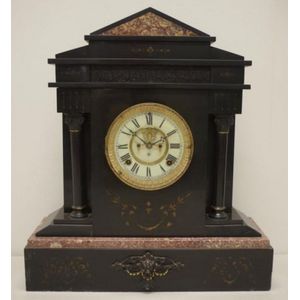Ansonia Mantel Clock with Visible Escapement in Marble Case
You must be a subscriber, and be logged in to view price and dealer details.
Subscribe Now to view actual auction price for this item
When you subscribe, you have the option of setting the currency in which to display prices to $Au, $US, $NZ or Stg.
- Movement - The technical name for the workings of a clock or watch, and does not include the dial or case.
- Pendulum - The pendulum was discovered around 1602 by Galileo Galilei, and was adopted for time keeping by the Dutch mathematician and natural philosopher, Christiaan Huygens, who excelled in astronomy, physics, and horology.
The pendulum comprises a metal rod usually of brass or steel with a metal disk, known as a bob, at the end. The movement of the pendulum is driven by weights or a spring, and as a pendulum swings in a regular arc, it was found accuracy could be controlled to within a few seconds a week.
Timekeeping can be adjusted by changing the height of the bob on the rod, making the pendulum either swing slower or faster.
The disadvantage of the pendulum was that changes in temperature also changed the length of the pendulum, interfering with the accuracy of the clock, and so in the 18th century two types of mercurial pendulums were invented which countered the movement in the steel rod.
The pendulum was the world's most accurate timekeeping technology until the invention of the quartz clock, regulated by a quartz crystal, in 1927.
This item has been included into following indexes:
- Ansonia (United States) - clocks, maker or retailer 316
-
clocks, material or decoration
- marble or slate 425
- slate 344
Visually similar items

An American black slate and marble mantle clock by the Ansonia clock Co New York, cream dial, black Roman numerals, eight day movement, 43 x 34 x 15 cm

A Sessions mantel clock, in black metal case, 32 cm in height

A J. Marti Medialle de bronze marble and slate mantle clock of grand proportions c.1880 complete with key and pendulum 50 cm high, 36 cm wide, 20 cm deep

French Medaille de Bronze mantle clock, with 8 day movement, in marble and slate case (some chips), movement striking has been removed, key and pendulum included, 33 x 14 cm
